Iran (Persia)
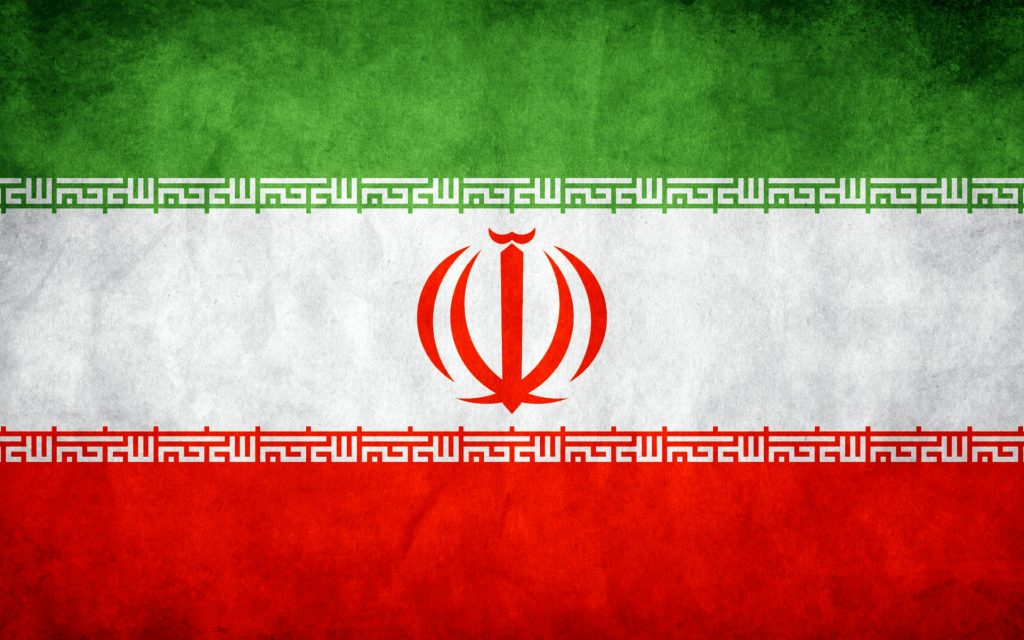
Official name: the Islamic Republic of Iran
Population: 81 000 000
Area: 1 648 195 km²
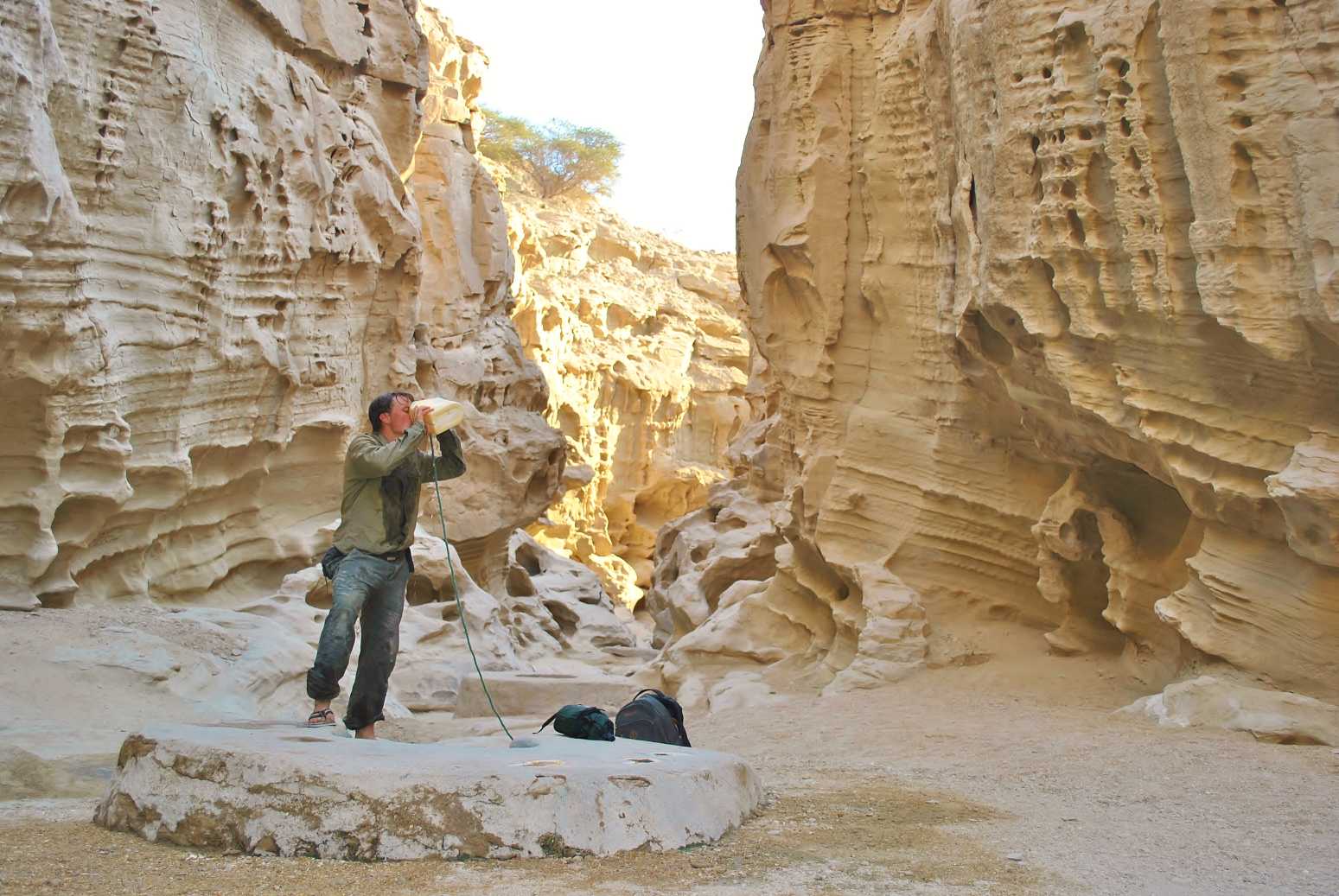
Gallery
The Iranian section cost me a lot work and I believe that it will be not only a guide to future travels but also an educational lecture about this very interesting country.
Kompas Travel is an independent medium, immune to political correctness and globalist propaganda, and it is not influenced by the mainstream media, what is seen in all articles.
Polish refugees in Iran
Before I get to the description of Iran, I would like to inform that as a Pole, I sincerely thank Iran for accepting 120.000 Polish refugees, who fled to Iran from Siberia in 1942. After Germany and Russia invaded Poland in 1939 and divided Polish territory, in the years 1939-41 the Communist regime of the Soviet Union deported about 1.7 million Poles to Siberia, 100,000 Polish women were raped, and around 500,000 Poles died during the fight against the Communist invaders . In the meantime, the repression of the Soviet Communists against Poles continued. The living conditions of Poles in Siberia were so catastrophic, that most of them died of cold and starvation, working themselves to death in the COMMUNIST DEATH CAMPS ! ! !
“The first government of the Soviet Union was 80% – 85% Jewish.”
– Russian President Vladimir Putin
In 1942 began the exodus of surviving Poles to Iran, across the Caspian Sea. A total of about 120.000 Poles found safe refuge in Iran. Among them were malnourished and suffering from diseases and hunger Polish women and children. Iranians treated Poles with respect, took care of them, and educated Polish children in Polish. Polish soldiers went to Iraq to train there, and then returned to Europe to fight against Germany. However, many Poles remained in Iran, and the Iranians were so good that they even gave the Poles shelters in government buildings. In the years 1942 – 1945 over 2,000 Polish children passed through Isfahan, which is why Isfahan was briefly called “the city of Polish children”.
Today in Tehran there is a Polish Cemetery, with 1937 Polish graves. I sincerely thank Iran for this noble act. God bless your beautiful country and its good people.
Polish cemery in Tehran – https://en.wikipedia.org/wiki/Polish_Cemetery_in_Tehran
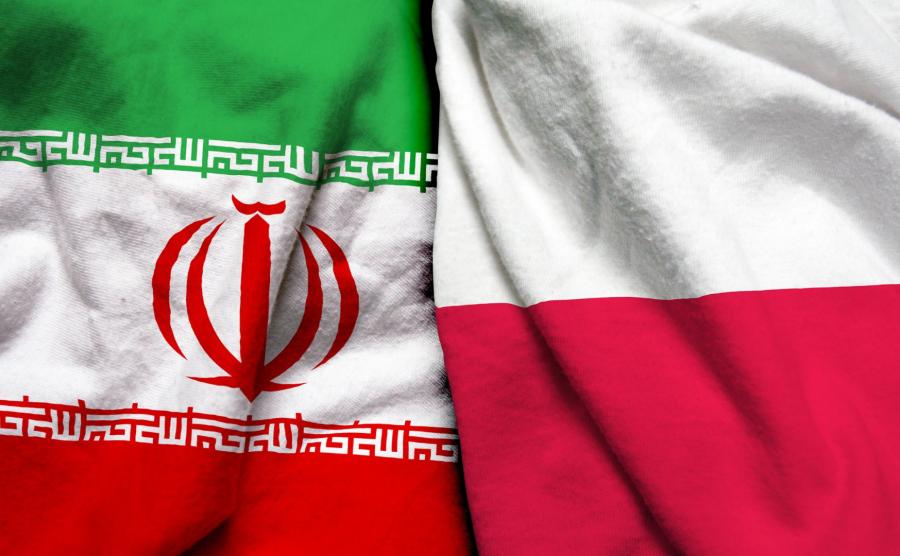
Flags of Poland and Iran.
Tourist attractions of Iran, Iran – the present times (“the axis of evil”), the real history of Iran in its most interesting moments, Ayatollah Ruhollah Chomeini.
Tourist attractions of Iran
After the Caucasus I began my journey around Iran which proved to be so interesting and full of so many adventures that I stayed there 1 month and 10 days. I got to Persia from Armenia what allowed me to see north, including the rock town of Kandovan. Because of the hate propaganda Iran is a very unpopular country. All we hear about Iran in our media is the nuclear program, alleged terrorism and religious fanaticism but after 1.5 month of travelling I realized that Iran is a big, educational adventure. I entered Iran from Armenia and then I was moving south stopping in the most interesting places and finishing in the Persian Gulf. Let’s not expect that Iran of the 21st century will be a land from the Stories of One Thousand and One Nights but because I had enough time for my trip I realized that ancient Persia is still visible in Iran. Iran has a lot of tourist attractions and from my own experience I divide them into: sights, art, natural beauty, gardens, traditional Persian food and good people. If I had to describe Iran in a few words I would say: mosques, bazaars, kebabs, carpets and good people.
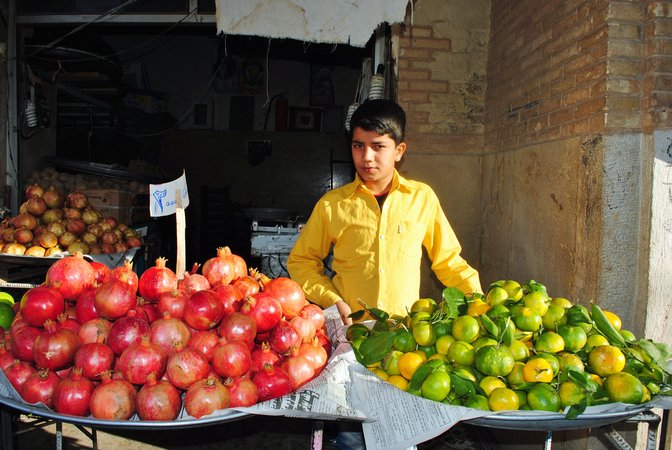
Iranian boy selling fruit in the city of Kashan.
Only in Tehran I spent about one week and it wasn’t a wasted time because I also went to Tajrish in the north and was climbing the mountains. Of course there are three attractions of Iran which are unmissable and these are the cities of Esfahan, Shiraz and Yazd. To tourists but also to historians they are the must see places which show the beauty of Persian architecture, rich mosaic and of course carpets. I also highly recommend bazaars where tourists can spend a whole day and never get bored. Whilst navigating the mazes of traditional bazaars built several centuries ago, and which by the way are pieces of art of their own, I often sat down to enjoy many types of tea and shortly afterwards I went to a carpet shop. Every region in Iran has its own traditional design, as well as glassware and elaborately decorated pots and plates. In the middle of each square which usually bears the name of Khomeini there is a decorated fountain and mosques, palaces and bazaars. It is also worth mentioning that bazaars are also very closely linked with the political life of Iran. Any dissatisfaction is usually heard first in the bazaars and the “bazaaris” financed political revolutions.
Every city is slightly different and that’s why we shouldn’t judge the whole country by just one city. The desert city of Yazd gave me an impression as if it had been built from a desert itself and not from a blue mosaic seen everywhere else. I also like Kashan and its old mosques and caravanserais. I lived there in a hotel built in the 19th century with a fountain in the middle built in a traditional Persian way. I also visited 2000 year old villages which are included into UNESCO world heritage. One of them was Abyaneh built entirely from a red sand stone and the other one was a small hill station called Masuleh. Another obligatory place to be seen in Iran are the ruins of Persepolis nor far from Shiraz. It’s a former capital of the Persian Empire built around 500-330 BC which strikes with its historical richness.
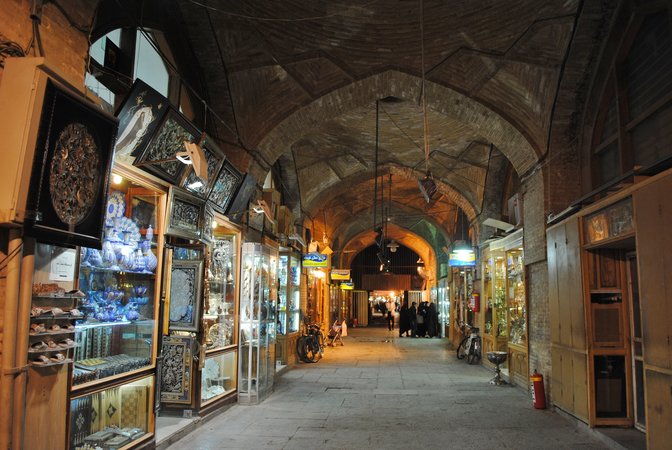
Traditional bazaar in Iran.
When it comes to a close contact with a nature Iran also doesn’t stay behind. From Tehran I went to climb Mount Damavand which is the highest peak of the Middle East and I went up to 4200m above the sea level. I didn’t climb any higher due to lack of equipment and additional costs but I saw beautiful nature and donkey transport in Alborz Mountains. From the city of Hamadan I went to Ali Sadr water cave and when I was in a desert city of Kerman I hitchhiked to Kaluts, up to 10 storeys high sand stone formations. I was climbing them having only sand, wind and a total emptiness as my companions and then I slept in a Million Star hotel. I mean that I was sleeping under open sky but only to the moment when a sand storm combined with heavy rain brutally interrupted my sleep and I had to move into my tent. Kaluts were beautiful, a taken out this world experience but not the only one. When I was for example in a rarely visited desert town of Tabas I went to an oasis in a desert which was not even on all maps. I went to Ezmirghan, a oasis where I saw grazing goats and the landscape consisting of date palm trees and a spring with crystal clean water.
I also liked the Persian Gulf and the Strait of Hormoz which in the Western media are equal to war over oil and a smuggling business; which is actually true. I spent one week over there; first in Bandar Abbas and later in the islands of Qeshm and Hormoz. My life in Qeshm proved to be very hard but it turned out to be an adventure of my life. I travelled around Qeshm by hitchhiking and on foot, sometimes passing through herds of wild camels and a beautifully formed canyon with wells inside it. I want to stress that whilst travelling around the Persian Gulf I experienced very hard moments because I was running out of water, I was several kilometres from civilization and the temperature reached 45°C. I also went to Namakdan which is the largest salt cave in the world and then on a boat trip around mangrove forest. When I left Qeshm I was exhausted because I slept in a desert for seven days and I had my baths only in the sea. My clothes were destroyed from the sun and sweat and I lost 4kg in one week – but it was a great experience. Then I sailed to the Hormoz Island with its ruins of the Portuguese fort.
I also went a few times to small towns such as for example Bam where I saw an ark destroyed by an earthquake and then to Mahan and Rayen where there was no place to sleep and it was too cold in a tent so I slept in a school. I was moving around by hitchhiking and I ate good Persian food. I spent nearly 1.5 months in Iran and it was one of my best travel experiences. To my great surprise I also had a good contact with women. They were interested where I was from, they hugged me a few times, they were very nice to me in general, interested in a relationship and one of them even asked me to bring her a vibrator from Poland when I come to Iran the next time.
When it comes to the Islamic Republic I went to the cities of Qom and Mashhad which are the holiest cities of Iran. Those places I also recommend and not only because of the sights but because they are very good places for observing people. It became clear to me that not everyone in Iran agrees with their conservative government and some of them even think that the never ending expansion of Haram does not make any sense. Iran is therefore a typical country which looks very bad on TV but it turns out to be a great travel experience. Helpful people are also a great advantage of Iran what I learnt many times. As a travel destination I definitely recommend Iran!
Iran – the present times
Economy
World Bank has classified Iran as a country of medium earnings of a lower level and it is an industrial, moderately developed economy. 55-60% is a centrally administered economy and dependent on oil and gas production, which give 80% profits from export. Iran is a second oil producer of the world (behind Saudi Arabia) and it is on the second place (behind Russia) when it comes to gas reserves. Throughout the years Iran’s economy was not diversified and dependent almost entirely on one sector, what resulted that the control of the government over the economy has frozen the private sector, and one of results of that kind of economy is flourishing corruption and inequality depending on occupation. For example soldiers and the government elite have economic privileges and better chances of promotion and others can count only on themselves. Currently the Iranian economy is in a process of transformation from centrally governed to a free market economy, especially the because of US sanctions Iran’s economy has weakened and that’s why Iran wants to be self-sufficient.
Because of sanctions foreign companies did not want to invest in Iran and trade has been limited, what has had its impact the government’s revenues and the lives of average Iranians. A good example is the fact that directly because of sanctions the oil export has shrunk by half, what translates into a big blow to a country where oil export amounts to 25% of GDP. Situation was so bad that for the first time since 1980 poor Iraq overtook Iran at oil export, and in 2012 the value of Rial lost its record value to American dollar. Iran lost also in such a way that a lot of educated Iranians were looking for a job abroad because Iran could not offer them fair salaries. Apart from the very important service sector there is also industry such as mining or agriculture, although that one lost in popularity because a lot people have moved from villages to big cities. Iran’s GDP in 2012 reached a level of $549.9 bln what is only 1% of the world’s economy. Iran’s GDP among many other things consists of: service sector (45% of GDP), production and mining (20%), agriculture (10%) and oil (25%). It is important to add that Iran is going to keep on investing in oil extraction, and for example in 2012 even taking sanctions into account Iran was still able to export 1.5 bln of oil barrels, and experts have predicted that in 2015 Iran’s yearly profit just from oil might reach $250 bln.
There is also another side of the coin because the Iranian government spends 25% of its GDP on subsidies to make oil and electricity as cheap as it is only possible. As a result of this politics oil consumption has risen by 10% annually. I’ve mentioned that Iran is a powerful oil extractor but on the other hand the equipment is dated and it requires new investments, what means that every year Iran has to import about 45% of its own oil mainly in a form of petrol, because it does not process it by itself. Iranian experts have asked why some of the subsidies had not been spent towards renovation of old equipment, and I think that because of self-efficiency plans this target will have to be met. “Bonyad” are also a unique part of the Iranian economy. They are religious businessmen who are exempt from paying taxes and who owe about 20% of the country’s GDP. They have about 120 organisations exempt from taxes which exist from all kinds of subsidies and they also control a big part service sector and production sector but they are very corrupt, they don’t bring any profits and they compete with a private sector. In my point of view they are religious pests and I think that partly it answers the question who steals money from the Imam Reza mausoleum in Mashhad, Qom and other religious places. Islam is a great business in Iran at the cost of average people and the country’s GDP.
I listed above very generally different parts of Iranian economy, but to describe this matter more precisely of course every sector can be divided into many specializations. Depending on a sector they are steel and chemicals factories, construction, banking and insurance, extraction of valuable and semi valuable metals, real estate, manufacturing of clothing and very good shoes (I bought two pairs), transport, road construction, telecommunications, car manufacturing (18th position in the world), dam building, pharmaceuticals, and such things as rice cultivation, nuts, spices and whole industries related to production of dried fruits. I have used the above examples to show that the overall division of GDP is sometimes too general to have a good idea about the country, because Iran does a lot of services and produces virtually everything. When it comes to the private sector the main products are pistachios and handmade carpets ($500 million per year in export). In addition Iran has a free trade zone in the Persian Gulf, which on the other hand is also a centre of illegal imports. Drugs are a huge problem in Iran and every year the country loses $8.5bn to drugs.
Currently in Iran about 18.7% (30 million) of the population lives in poverty, which is for about $12 a day; and about 3.1% (10 million) lives in extreme poverty which is for about $ 2 a day. Unemployment stands at approximately 15% overall, although among young people (15-24) is as high as 24%. When it comes to inflation in Iran various legends circulate around that subject, but in a course of a month long trip prices may change a little. Recently the Iranian government has argued that inflation stood at 13%, but Iranians are not fools and they knew that it was around 25%. Unfortunately when I read reports from December 2013 Iran could “show off” with an inflation of about 36% to as high as 40%. Currently unemployment and high inflation, and hence the loss in value of Rial are the main worries of the Iranian government.
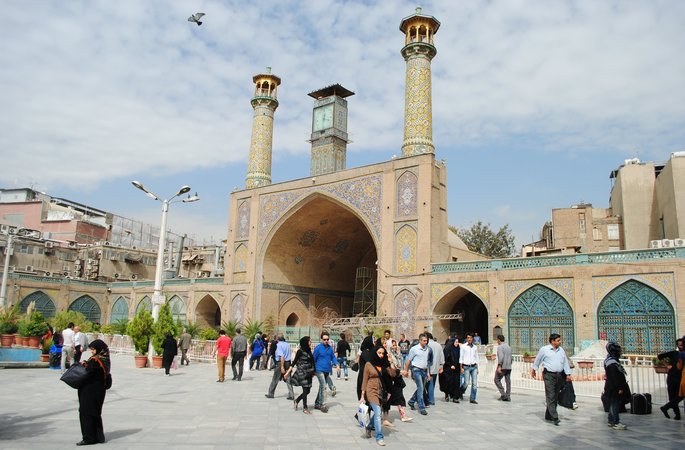
Square in Tehran. Iran.
“The axis of evil”
We’ve all heard the horror stories in the media about Iran as the “axis of evil” and that it works on nuclear weapons. I find these stories to be exaggerated thrillers for naive children, in which unfortunately whole nations believe. I assure everyone that behind all lies always hides economics and lust for power.
According to Goldman Sachs Iran has the potential to be one of the most powerful economies of the twenty-first century, which is why the West fearing for its influence wants to stop Iran’s economic growth because it would have a disastrous effect on them. Where diplomacy does not help military force does and by taking the natural resources, by setting up economic control and by building strategic advantage in someone else’s region the West guarantees itself economic growth. Besides, paying for the army and investing billions each year in new weaponry, in some countries is genuinely for defensive reasons but in others countries it is an investment which must pay back; and such country is the USA. Despite this I think that it would be still better if Muslim countries did not have nuclear weapons although I don’t understand why Pakistan had not been stopped.
When it comes to accusing Iran of terrorism I believe that to some extent it is true but I also believe that the West is perfectly worth Iran because politics is a story that lacks a positive character. I also believe that any acts of terrorism organized by Iran are a direct response to the Western politics, whilst Muslim terrorism does not come from Iran but mainly from countries allied with the United States, such as: Pakistan, Saudi Arabia, Egypt and Afghanistan.
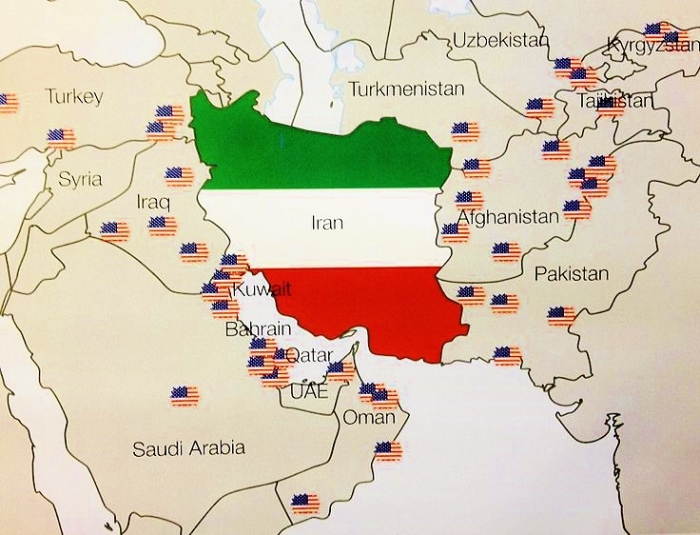
The United States has more than 40 military bases in all Muslim countries around Iran. In addition, the United States has a destroyer and a submarine in Persian Gulf with its nuclear warheads, plus an unlawfully established military base of Israel which is burning with hatred for Iran. Therefore, who poses danger to whom?
When it comes to cutting off Iran from the rest of the world I see it in the following way: the U.S. captured Iraq and Afghanistan and has military bases in almost every Arab country and it has the military base of Israel. This means that Iran is cornered and cut off from the world. Let’s imagine that Iran would have enough military and enough political and medial power to conquer Canada and Mexico, plant a huge army in Cuba and destroyers and the Gulf of Mexico. Then Iran would cut off the U.S. from the rest of the world and it would call it the “axis of evil”. This is exactly what America is doing to Iran for its own economic benefits. Meanwhile, stupid American and British people believe that Iranians are born evil. People would believe anything.
Education
Education in Iran stands at a higher level than in many other Muslim countries and education for women is in usually as open to them as to men. Literacy stands at a level of 85% and literacy among young people (15-24) at a level of 97% without any gender difference. For example an average literacy in the region is only 62% with bid gender differences and in the neighbouring Pakistan only 53% can read and write.
In theory education is free and compulsory but in practice it looks slightly different. Only 50% are enrolled to preschools and primary schools start at the age of 6 and it takes 5 years, but based on data from 2004 full enrollment has never been achieved. Then there two stages of secondary schooling where each one of them takes 3 years and the first one is compulsory and the second one is not. The first 3 years are designed to check the talents of young people and direct them professionally for the end of compulsory education. The second 3 year stage of secondary schooling is not compulsory and this part of education is for youth from age 14 to 17. Enrollment of this stage of education stands at a level of 80% and on average 6% of this education is private. The second stage of the secondary schooling is divided into 3 parts which educates in trade, industry, literature, mathematics and many more subjects. After that, for people at an age of 17 -19 there are two-year technical studies which prepare to a specific job. Another path is a pre-university year college which gives an opportunity to file documents to universities. Then there are 4 year bachelor studies and after them a 2 year university which completion gives a master’s degree title. At a bachelor level the government pays for 4 year studies and also for upkeep at the Islamic Azad University. After the above mentioned 2 year university there is also a 3 year doctorate program, and Iran has the most prestigious universities in West Asia (or in the Middle East for those who like overusing this name without understanding it). I also want to add that according to SCImago which is the world indicator of scientific influence, Iran has 3 universities which are in the first 1000 of the world. 20% of the country’s expenditures are spent on education, which is 5% of the GDP. It is therefore a bigger percentage than in other developing countries. Also foreign languages are very popular and the most popular one is English. Currently there are more than 5000 language schools and a lot of Western schools. More and more schools are equipped in internet which helps in education. Every year Iran has about 3.5m students at universities, including 1m at medical universities.
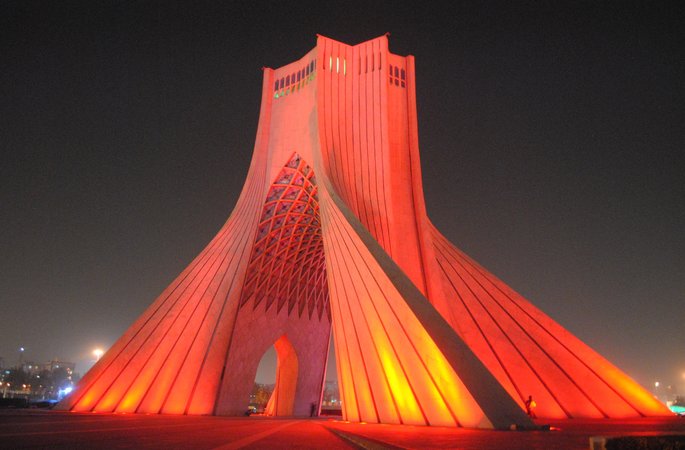
Azadi tower in Tehran. Iran.
Islamization of education and the role of women:
My description of education in Iran can look very good at first, but let’s not forget that Iran has also its second side, which is the “Islamic Republic”.
Soon after the Islamic revolution all schools and universities became a subject of Muslim observation and women were discriminated. Most did not have entry to universities because teachers were men. However as the years passed women achieved equal rights, or at least so it looks. According to the constitution of Iran everybody regardless of sex have access to education of all levels. Despite that after Khomeini came to power the rules significantly hurt women; on the other hand a lot of women’s movements were created which fought for their rights. After Khomeini’s death most prohibitions were lifted, although today in many universities, canteens and libraries sexes are separated. Currently women in Iran represent 50% of university graduates and 70% of graduates at engineering studies. This situation does not fit with the Muslim regime which insists into a greater sex separation and so called “gender balance” in certain fields. In technical studies recruitment of women is limited and at universities where the main subject is oil extraction women are not allowed in at all.
The Muslim regime excuses itself in a very diplomatic way, saying that it is for the women’s well being because in technical jobs like for example oil extraction women would be 98% unemployed. Besides, according to the Iranian government there are not enough female dorms, what means that women in Iran will never be physicians, archaeologists, IT experts or business women. Based however on the research and on my own opinion the Iranian government is simply worried about this situation because at certain universities women constitute even 68% of students and women achieve better results at education. On the other hand I understand the limits and I don’t even think that they have anything to do with Islam. If any country in the world had all women scientists than such a situation would lead to decline in marriages and procreation what argues not only with a Muslim but with every other model of a family. Women also do not have entry to the library section with English literature. On the other hand nursing studies are open only to women. From time to time there are also extreme events which prove that the Muslim regime tries to force Islam on people who are simply not interested in it at all. Once at the Azad Islamic University a woman was beaten up by the personnel because she did it not want to wear a hijab (black sheet).
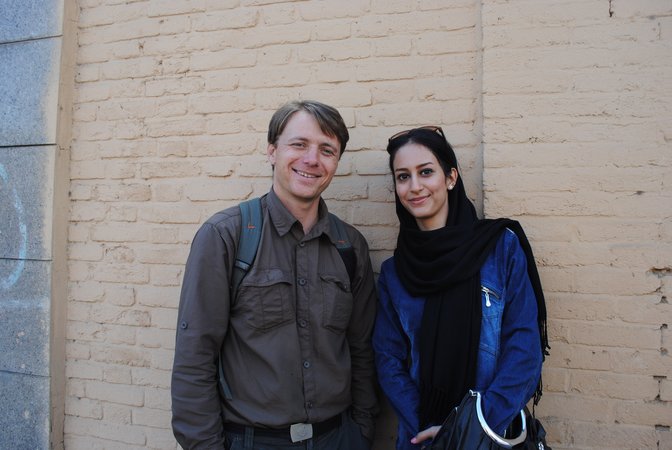
With a Persian kitten.
Health
Iran is one of the most populated countries of its region and more than half of the Iran’s population is below 35 years of age (data from 2013). At this age people form families and if their children are there to build Iran and its economy, apart from education, safety and many other things the government should guarantee a good health care. After the Islamic revolution the conservative government of clerics forbid all contraception but they quickly changed their mind when the population almost doubled. For example in 1980, so just one year after the Islamic revolution the population of Iran was 40m, in 2000 it was 60m and in 2013 it was 76m. In such conditions the health care system should be very reliable and in the recent years it has improved and has more equally distributed in cities and in the country sides. According to data from 2008 the health care system in Iran was worth $24.3m but in 2013 it stood already at about $50m and it is foreseen to keep growing. According to the constitution every citizen has a right to a free health care and taking different countries into account such statement was a pure fiction. In Iran however this situation is very close to truth. Most Persians have access to free jabs and medications, and in every small village there are also medical practices which offer help for small prices, and in the cites there are also private clinics which the same as their prices also stand on a higher level. About 85% of people are insured and access to medications and to the health service stands at a level of 86% in villages and at 100% in cities.
Unfortunately in villages there is a lack of equipment because clinics which are far away from big cities are not fully covered. Iran has also very well educated doctors and health care personnel and it is self sufficient in this subject. There are also enough hospitals and equipment and there are 7 nurses and 17 hospital beds per 10.000 persons. These may sound as small numbers although especially my last sentence is very important. For a comparison when I was in a hospital in India I had to buy a syringe and a plaster and when I saw the hospital I was so scared that I made the necessary injections by myself in a hotel. For example in Bangladesh there are only 4 hospital beds per 10.000 people and only 8 midwives per 1000 families, what leads to a big maternal deaths during live pregnancies. On the other hand Iran is a popular medical tourism destination. Every year about 30.000 people come to Iran for many different treatments.
When it comes to statistic data then the infant mortality stands at 28.6% per 1000 natural deaths; mortality of children to the age of 5 at 34 per 1000 and maternal mortality during live births at 25 per 1000. Apart from that vaccination for children and pregnant women are widely available and polio has been almost completely eliminated. It is also worth mentioning that when it comes to vaccines Iran does not want to let foreign companies onto its market and will soon be self-sufficient. 92% in rural areas have access to safe drinking water and in the cities it is 100%. In contrast, according to World Bank access to sanitation has 100% both in villages and in the cities what helped to eradicate tuberculosis. Unfortunately cholera is a big problem here and for example in 2005 there were 1118 infections and 21 deaths. Unfortunately cholera in Iran is a problem which returns and the government does not always want to talk about it. When in October 2013 I entered Iran from Armenia I was told that there was an epidemic again. I was disinfected just in case.
Looking at the malnutrition world map Iran is placed in the same category as all other developed countries, what means that statistically less than 5% of population is malnutrition. On the other hand however that map does not disclose everything because evidence show that 25% of all children in Iran are too small and it weights not enough for its age, what usually happens in small villages. On the other hand 35% of women and 15% of men in Iran are obese.
The main causes of death in Iran are cardiovascular disease, cancer and heart disease, although depression is also common. Many of these diseases and related deaths would be easy to avoid were if Iran was not a country of smokers. Iran has about 12 million smokers of which 80% start smoking before the age of 20. From year to year however there are more and more young women who also smoke. This is therefore one thing which is incompatible with Islamic regime but it is neglected.
Regarding HIV / AIDS, comparing to other countries it is not bad but the numbers are rising and the main reason is the drug injection and to a lesser extent sexual contacts. Currently there are approximately 100,000 people with HIV in Iran and the additional taboos associated with the disease limit better treatment. Iran has the largest population of drug addicts (2.8%) in the world what also has an effect on HIV infection. Iran has a 975 km border with Afghanistan which is the largest producer of drugs in the world.

Kaluts sand castles. Iran.
Culture/Religion
Before we elaborate on the subject I want to highlight that the traditional Persian culture and the pseudo culture relating to the Islamic republic are two different things. On one hand after all we have heard about Iran from the media we imagine this country only in terms of Islam without realizing that the traditional Persian culture is about much more than black sheets, mosques to the point of boredom and veiled heads. Typical Muslim stereotypes in Iran do exist but comparing to “Arabistan” or Pakistan; Iran culturally stands higher. It is also important to note that the culture of Persia has developed over millennia and many different empires in that land had their influence on Iran, which enriched and turned back Persia in different ways. Examples I want to give are invasions carried out by Turks, Mongols and Arabs as well as Europeans. I also think that especially after the Islamic revolution in 1979 a great inconsistency of cultural differences appeared what I often experienced during my trip. I spoke with a very conservative young women wrapped in black sheets who praised Islam and said that because they grew up in this culture they were able to accept all the limitations, but on the other hand I also spoke to girls who said that they looked stupid with their heads covered, and believed that Islam was hopeless and therefore should be only for Arabs as a lower race. That’s why when it comes to the culture of Persia it is good to separate it to the one before the revolution and after the Islamic revolution. Also because women play significant role in those differences.
I’ll start with the fact that when it comes to racial origin what interests me to a big degree Iran is quite diverse. Persians constitute of only 61 % of the population of Iran. Then there are Azerbaijanis (16%) and Turks (2%) living mainly in the north-west areas with the main city of Tabriz, Kurds (10%) living in the same area as Azeris but closer to the border between Iran and Turkey. Other interesting people of Iran are Lurs (6%) who live mainly in the south-western areas but today many of them still live domestically roaming Iran and living in tents. Lurs are closely connected with the Kurds whom they originally come from and their language is a dialect of Kurdish. Then there are also Baluchis (2%) who reside in areas of the south-eastern Pakistan, and Arabs (2%) living mainly in Khuzestan province in the north of the Persian Gulf, and in the south in the city of Bandar Abbas and Qeshm island. There are also other minorities such as Turkmens (2%) living mainly in the northern areas along the border with Turkmenistan and the rest all together represents about 1 % of the population of Iran. These are for example about 250 thousand Armenians, Georgians, Assyrians and Jews. Each of these races has its own language and distinct culture and sometimes religious too, but officially according to the government they are people of Iran. I personally do not think so because belonging to a particular country I personally determine primarily on the basis of race. This means that if for example Arabs or Negroes lived in Poland for three generations they would never be Poles, and this is regardless of knowledge of the Polish language because they do not meet the racial and cultural standards of the Polish nation. I think that the Iranian government partially agrees with me because “Persian ethnicity” exists when someone does not speak any regional language and does not have any cultural differences than traditional Persian. On the other hand, at first glance we can see a difference between Persians and Baluchis, Arabs or Turks. When it comes to the language the main one is Persian (Farsi), but on the other hand according to the research carried out in 2001 Persian language as the first is spoken by only 68 %, while others use their regional one as the first and Persian as the second one.
Religion is another important thing because Iran has not always been an Islamic Republic. Before the Arab invasion in the seventh century Zoroastrianism was the faith of ancient Persia, and currently we can see its huge reflection in art, culture and philosophy. Even without being aware of this fact to tourists it is an important part of every trip. Today the main religion of Iran is Islam (98%) and it is also important that it is the only country where Shia Islam represents as much as 89 %. Another important minority are Sunni Muslims (9%) who form majority all other Muslim countries and there are also other religious minorities (2%), such as Christians, Jews and Zoroastrians who can freely practice their faith. Even though there is a conflict between Iran and Israel over Palestine one seat in parliament is booked for a Jew. The only religion which is persecuted regardless of the freedom of religion guaranteed by the government is Bahai. Bahais exist in small communities throughout Iran and they have faithful ones in every ethnic minority. From what I’ve noticed attitude to me as a Christian is very good in Iran and people approach it seriously. There are also several ancient churches in Iran, mainly in the north because of the Armenian community and in Esfahan. Some of them have interesting frescoes inside but they all look like mosques with a cross on top.
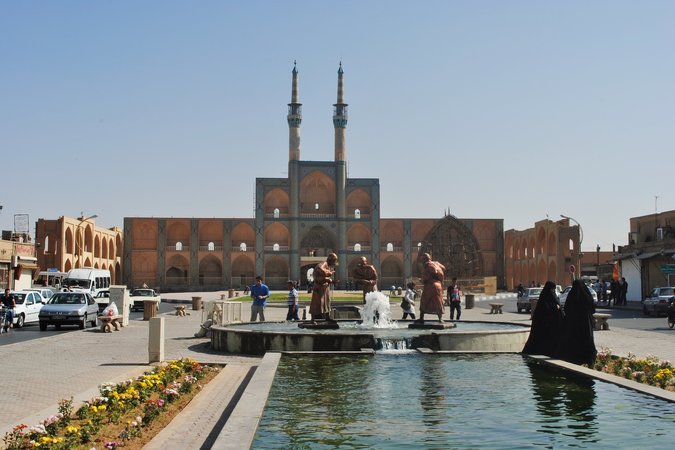
The old town of Yazd, which is a great art show, and gives the impression of being shaped out of a desert. Iran.
Markets are also an important part of Persian culture especially that they are not only used as commercial centres but also as places of social, political, cultural and religious character. For example the bazaar in the beautiful, historic city of Esfahan was built in the seventeenth century and it has richly decorated arches and mosaic labyrinths showing heart and soul of ancient Persia, which tourists in Iran wants to find. Richly decorated shops with silk, carpets and traditional sweets and spices attract traveller’s attention. Furthermore every bazaar has also its tea rooms where I made contact with Persians and answered a lot of questions, because in Iran everyone is very curious why a Polish traveller wants to visit their country. Whilst having tea, near a small fountain, behind a chamber with handmade rugs and with a pack of dates in hand tourists can have a very good time. In general every city in Iran has its bazaar but the best ones I recommend are in Esfahan, Tehran, Tabriz, Shiraz, Yazd and Kashan.
Bazaar in Tehran is about 10km in diameter and has been named a “city within a city”. Brides go there to find a husband but also to make contact with a nice tourist from Poland, the faithful ones go there to the Khomeini’s mosque although getting there involves finding a way in labyrinths, and those who have no money go there to take a loan at a lower rate for the bazaar’s retailers. This is not a joke, especially because formerly it was the “bazaaris” who gave loans for housing, cars, and also for weddings. Over the years bazaars have grown to political purposes and they are a symbol of Persian culture. Before the revolution some bazaaris financed the Islamic revolution and because of being in the centre of social and financial lives the nation’s dissatisfaction with the government was always felt first in bazaars. Whilst in bazaars I saw many interesting shops and vendors who sold things that I didn’t realize they could be sold. I drank tea, I ate kebabs and a man named Jaffar (the name of the villain from Aladdin) helped me to bargain a price for the carpet. We should also know where to sit because once in Yazd I sat down near copper pot makers what turned out to be a very noisy job. First bazaars in Iran were built in the fourth century before the Christ.
It is also worth to mention the carpet weaving culture and I refer to this speciality as a separate culture because in Iran traditional Persian carpets are of great importance. Each bazaar has a section devoted just to carpets and they are made either by machine (cheaper) or they are hand made. Apart from that each region of Iran and even every city has its own characteristic, traditional pattern, what means that a specialist can tell right away about the quality of this carpet and whether it comes from Tabriz, Esfahan or Mashhad. Art of Persian carpets is recognized around the world and it is not a surprise that Iran produces more carpets than all other countries taken together. I went once to the carpet museum in Tehran and I think that it is the best place to see every possible pattern from all sides of Persia. Persian rugs are not only colourful patterns, but also landscapes, carpet painting, family trees and history of Islam depicted on the paintings. I have also seen carpets with beautiful women and last supper. The choice was huge that’s why when it comes to bazaars and carpets I think that is the point of a trip to which every traveller would return.
Iran has also its traditional cuisine and its dishes are deeply rooted in the Persian culture. The basis of Persian meal is thin bread in many forms or rice, which according to folk belief is a symbol of approaching God. In certain way I do agree with it because rice with butter and Persian delicacies taste truly divine. Apart from that there are various types of meat in a form of kebab and shish kebab, usually with beef, chicken or lamb. Persian food is very healthy because rice is cooked and meat is grilled, as well as vegetables, usually tomatoes, peppers and mushrooms. Iran has also popular sweets such as baklava, but it should be reminded that they are all based on milk, honey, nuts, almonds, egg yolks, various corns and lemon juice. The main drinks are yogurt and tea, both black and green and also flower tea. Unfortunately these days fast food restaurants have become very popular in Iran and even though they are disgusting Iranians like them because they are fed up with traditional food. Tearooms (chaykhana) are also very popular and they serve tea in small kettles with sugar and sweets although sometimes they also serve traditional meals. Earlier I noticed similar customs in Tajikistan and Kyrgyzstan. I will always remember a traditional bath house in the city of Kerman which used to belong to one of the sultans and was converted into a chaykhana. I rested there on the wooden bed, I leaned against pillows and a band played traditional songs.
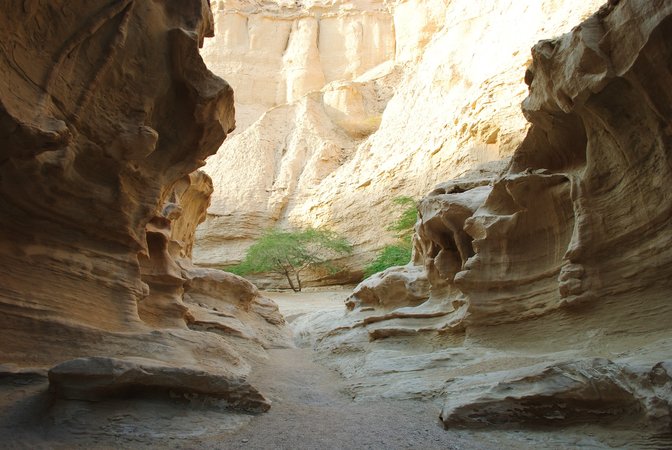
Canyon on Qeshm Island. Iran.
Gardens are also an important part of Persian culture and they are intended to reflect paradise on earth. Persian gardens usually consist of fountains, or a long and sometimes a high object with a water feature and plants all around. For example in a garden in Shiraz there were lemon trees and red flowers which were surrounded by a traditional Persian architecture with arches, mirror mosaics and frescoes on selected parts of the walls.
Persian architecture is yet another important and a very big issue, because through its art it is to symbolise bringing of man to heaven. I divide Persian architecture Persian into: mosques, gardens, markets, pavilions, bath houses, tea houses, mausoleums, carved caves and also fortified walls and even ice houses. To traditional Persian architecture I also include ancient cities from the pre-Islamic times such as Persepolis with its characteristic sculptures, columns and sculptures. I also recommend palaces in Shiraz and Tehran and traditional merchant’s houses in Kashan which represent a lot more than just homes. Other buildings worth recommending are also the ark in Rayneh and destroyed but rebuilt the ark of Bam, and also the historic bridges in Esfahan. Mosques in Iran are usually covered with blue mosaic although there are several in Kashan and Yazd which are in a colour of desert. Merchant’s houses in Kashan and all the mosques and gardens and baths and tea houses with characteristic arches and pillars as well as paintings and mosaics made from small mirrors. Buildings are usually accompanied by gardens and for example place such as Khomeini’s Square in Esfahan or merchant’s houses in Kashan and many gardens are constructed geometrically; and there is always a pool with fountains in the middle. Iran also translates into minarets of different thicknesses and heights and gates with arches surrounded by mosaics, like for example a huge gate in the desert city of Yazd. Other styles are fortresses from the pre-Persian times such as Choqa Zanbil near the border with Iraq, and Zoroastrian temples with fire in the middle (the best one I have seen in Azerbaijan). In addition to its geometrics involving construction planning in shape of triangles, half circles and rectangles Persian architecture is also a style of continuation and repetition of the same elements, which in my opinion are the best seen by looking at historic bridges of Esfahan. As for the materials used in the past they were always those which were easy to find in a specific region of Iran. For example in the desert city of Yazd the oldest part of the ancient city is moulded from clay and sawdust and roofs are supported by wooden logs what gives an impressive effect. It is the same with arks in Rayneh and Bam.
Iran has also its cinema, music, literature and art which previously used to show for example women playing on instruments or women feeding men with grapes. However after the Islamic revolution in 1979 art took a different character. When I talk about art I don’t only mean paintings in numerous galleries but also frescoes on the walls in gardens, baths and palaces. I also advise to look up to not to miss anything. Persia has also a very well developed poetry and the poets which are worth reminding are Ferdowsi and Rudaki, who is also popular in Tajikistan. When I was crossing Iran by buses they always plays films and from what I noticed Iranian women were not polite or obedient. It is a cinema which promotes the culture of Islam at a family and professional background where woman is often the boss, she argues and rules men, at the same time having her head covered and living by the rules of her culture.
I think that an important part of Persian Culture is the hospitality and kindness toward tourists, especially that hardly anyone wants to visit the country of “terrorists”. Whilst travelling around Iran people often asked me why I decided to come to Iran and they also asked me a lot of questions of political nature, as well as about my family and my country. Once a Persian family took me from a bus station and invited me home. They asked me if I had friends in Iran and then they took me home. They gave me a dinner and I spent a night with them. Another man in the mountains took me to the house for a low price and advised how to climb Damavand. I used the hitchhiking for hundreds of kilometres and I always felt well and safe. Persians are generally a friendly nation and the only limitation in touch with them lies in the fact that hardly anyone speaks English well enough. On the other hand Iranians are also very curious, that’s why the information we dispense should be limited. Sometimes people stopped me in the street to ask me some questions. In Europe this would be unbelievable.
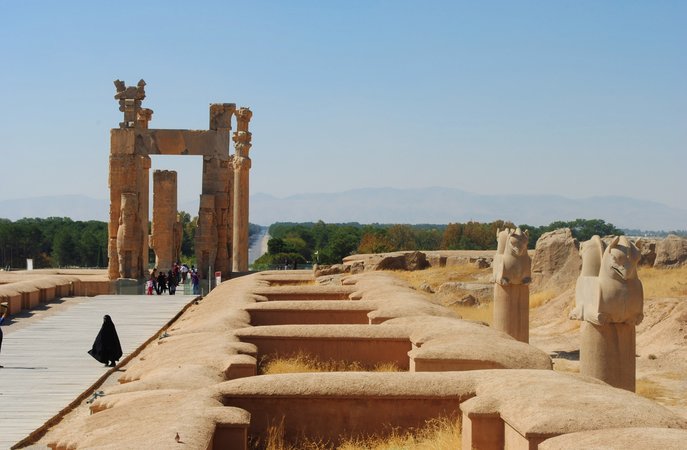
The ruins of the ancient capital of Persia – Persepolis. Iran.
Women also play a big role in Iran although this is a topic which changed after the Islamic revolution in 1979. Before the Islamic Revolution Iranian women did not have to cover their faces. They used to dress in a European style and in the beaches they wore swim suits. When Ayatollah Khomeini came to power and ordered all women to wear hijab (black sheet covering the entire body) a lot of them protested against the Muslim law. Currently some women wrap themselves that way and the other dress modestly but without a hijab only wearing a headscarf revealing almost an entire head. We can tell a lot about the differences in women’s lives before and after the revolution, but in my opinion, at the time of the Shah women had more freedom. Shah introduced many new laws like for example right to divorce and custody of children, inheritance, family planning, and marriage from the age of 18, a right to vote. All these laws exist in Iran today but in general it is better to be born as a man. Shah forbid to wear hijab but some women who wanted to show their support for Khomeini wore it anyway. After the revolution hijab became mandatory in public places such as universities and women have had to enter buses through a separate entrance, and despite equality in politics and colleges limitations do exist.
Iran is not a type of Islamic republic which completely lost its mind in the name of religion. Women can vote and drive a car, they have high results at education and international sports, but unfortunately even those women who do not want to wear a hijab they still have to. There is also religious police in Iran which works directly at the order of a leader Ali Khamenei, and they punish women for a poor dress code. This means that a few years ago in Tehran hundreds of women were arrested for wearing a hijab and chador in a negligent way what means rolled up sleeves and a scarf intentionally “gliding” behind their ears. I personally call such women “Gummy bears” because of their frontal hair coming out of their scarves and their big smiles to me and clear hatred towards the Ogres in the form of the religious police they look just like Gummy bears. In theory such women could get up to 70 lashes and two months in jail. It happened to me that I had cuddly photos with young Iranian women in a park and someone caused an argument about it. Another time young women were stocked by the moral police and when they saw me one of them began to pretend that she was my wife. We hugged to a picture and police went the other way. I have a few stories of that kind but in general I do not think that women in Iran are free.
Overall I think that Persian culture is very interesting, rich and worthy of exploration. I also noticed that it is a culture which suffers in the same way as the traditional culture of European countries. I’m talking about excessive immigration from other countries, the fact that 32% of population speaks Persian as a second language and that a conservative Muslim regime also contributes to the killing of traditional Persian culture. For a comparison in Western Europe the situation is much more serious because the ultra-liberal governments import foreign people who are culturally and racially alien and by mixing of races and acceptance homosexuality as something normal they kill the White race and Christian values preserved for thousands of years. I believe that for the survival of a certain culture, regardless of whether it is in Poland or Persia, racial and cultural purity are extremely necessary, as well as the fight against political correctness and ultra-liberalism.
Media and the meaning of the „Iranian freedom”
Freedom of speech and freedom of the press in Iran could be compared to a high security prison. Before I go into detail I want to say that on the press freedom index on 179 countries and territories Iran takes 174th place, which is only about 4 positions better than North Korea. During my trip around Iran in 2013 I experienced a lot of interesting but also very strange things. Iran has a president who is just a figurehead but the real power is in hands of the highest Muslim cleric and he is the one who has the last word. All television and radio stations, as well as all publishers are controlled, but it is better to say that they are controlled by Muslim clerics. Writers, inconvenient politicians, activists and poets are regularly killed by the Islamic regime in many ways. These are mostly gunshot wounds, knife stabbings, and all kinds of accidents including injections of potassium to induce a heart attack. That way entire families are killed and Iran still denies it and it also denies that it has political prisoners. In general being a journalist or a television presenter is associated with loss of life or health. When it comes to my personal observations I have a lot of them because I saw them in Iran on daily basis. There is no need to carry out specific research or work in politics or the media to quickly realize that the Iranian government wants to control everything including dress code and private lives of its citizens. According to conservative Islamic principles there is a specific dress code for women and there is an especially appointed religious/moral police whose job is to make sure that women comply with those standards.
A lot of women do not agree with the Islamic law and that’s why they pull up the tops to their elbows, they pull down their scarves head covers at the same time looking at the police and checking how far they can go. A lot of women and men told me openly about their hatred towards Islam and about the fact that covering women that way looks stupid. Once on the street in Iran young girls helped me find the address and they also wanted to practice their English, but when police saw us together they gave them a cold look and the girls run away. Young Iranians told me that they would like to be free but unfortunately in Iran the government controls its people to such an extent that they can not even drink alcohol, they can not dance and there are no night clubs. I know one example of a Polish tourist who met a nice Iranian woman and she wanted to spend a night with him but hotels did not want to give them a room because they were not married. The solution to it is a temporary marriage or the women’s house, provided that she lives alone, what in Iran is very rare.
In a certain way it is also quite funny to me that internet is explicitly blocked. For example the U.S. government gives uplifting speeches about freedom although they want to have an absolute control, but in Iran the government does not even bother to lie. Websites such as Facebook or other political and media sites, and even my page are blocked in Iran. For example upon entry to Facebook a filter appears which blocks a banned site. Iranians however try to have as much freedom as they are able to. They go to Armenia where they drink and dance and then they go back to Iran with a hangover. When I saw Iranian women at the airport in Constantinople (Istanbul) first they removed their black sheets and they worked on their make up. It is therefore a never-ending game between the Iranian people and their government.
I hope that this article explains deeper not only the press freedom or rather complete lack of it but also the Muslim regime and the way some people deal with the Muslim nonsense. I also want to add that during the Islamic Revolution when Ayatollah Khomeini came to power a lot of women protested against wearing a hijab (black sheet covering the whole body). I have been in many Muslim countries and it is always an interesting adventure worth exploration, especially when it comes to the natural beauty of those countries. On the other hand, according to me the extreme Islam is not a religion but a sick ideology requiring psychiatric treatment.
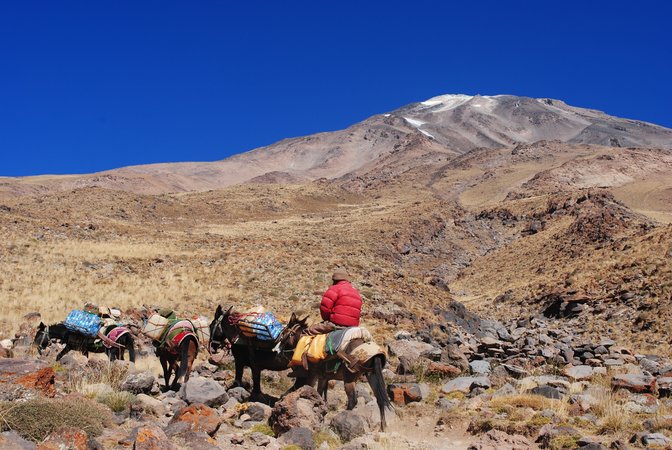
On the way to Damavand. Iran.
Environmental issues
Iran is a very dirty country and it faces many problems related to environmental protection. The worst situation is in large cities such as Tehran, which is on a list of the most polluted cities in the world. For example the not so proud winner in a competition for the most polluted city in the world goes to Ahwaz in western Iran, which is t he main centre of crude oil production and a heavy industry. The major air pollution in Iran is caused by heavy industry and traffic which goes hand in hand with noise pollution. The Iranian government has ideas to control traffic and the use of bicycles but these are only plans. Other pollution are associated with excessive cattle grazing, and changing paradise into a desert without trees. Whilst crossing Iran it was easy to see that Iran is fully covered by hot deserts and greenery is only visible just to the north at the shore of the Caspian Sea. There are also industry-related pollution and its regular sewage release into rivers, and oil extraction which resulted in pollution of the Caspian Sea (the same as in Azerbaijan) and the Persian Gulf by oil and chemical waste. Especially in Iran where large part of the economy is based on oil production marine life has been very affected. As far as the relationship with the economy goes it has been calculated that only due to environmental contamination, treatment and people deaths will cost the Iranian government about one billion U.S. dollars every year or approximately 1% of its GDP. There are many signed agreements on environmental pollution in Iran that never see any action in this connection. For example, daily Iran produces 50,000 tonnes of waste, of which only 70 % – 80 % is recycled in an environmentally friendly way.
Despite this Iran still has tropical forests and many beautiful animal species. Unfortunately Iran has now also 20 endangered species of mammals and 14 species of endangered birds, and I suspect that Iran would also want to have but unfortunately it doesn’t have Asian lions and Caspian tigers. These two species went extinct in the twentieth century and considering oil extraction sea turtles are next in line.
The real history of Iran in its most interesting moments
Introduction
Iran’s history is very long and stormy. It is a story of many fights between different empires and it’s an interesting adventure which could not be ignored by such rich in history countries like China or India. Because of constant invasions of different cultures it is a story of changing dynasties, philosophies, cultures, arts, architectures and poetry. Iran is one of the oldest countries in the world and that is why its history is so extensive that it can’t be told just in a few sentences. Persia is surrounded by seas and mountains and it has strategically a very important position; it was always a target of attacks and it always conquered others. During its long history Persia among many other invaders was conquered and ruled by Alexander the Great in 330 BC, by Arabs in the seventh century, by Turks in the tenth century, and by the Mongols in the thirteenth and fourteenth centuries. Finally the Persian Empire (Achaemenid Empire 550 -330 BC) which scope covered the whole of Asia Minor as far as to the Balkans, Syria, Jordan, Israel, part of Egypt, south Caucasus, part of Central Asia, Afghanistan, part of Pakistan and the whole territory of current Iran. It was a very vast and powerful empire which in the west was stopped by Greece and in the east India which was partially within the empire tried to protect itself from further expansion. The most powerful rulers were Darius I and his son Xerxes who built the famous Persepolis. After death of Xerxes the empire began to weaken and Darius III was the last ruler whose empire was conquered by Alexander the Great.
It is also important to remind about two cultural aspects of Iranian history. Currently many Iranians do not agree with Islam because they are tired of the regime but when Arabs conquered Persia in the seventh century Persians were not forced to adopt the religion. What’s more they adopted the teachings of Islam voluntarily and with great enjoyment because it seemed to them more attractive than Zoroastrianism which prevailed for centuries. Another important event is the work of a poet Ferdosi called “The book of kings” which he wrote between 1990 and 1020 and which is considered as the basis of the Persian language (Farsi).
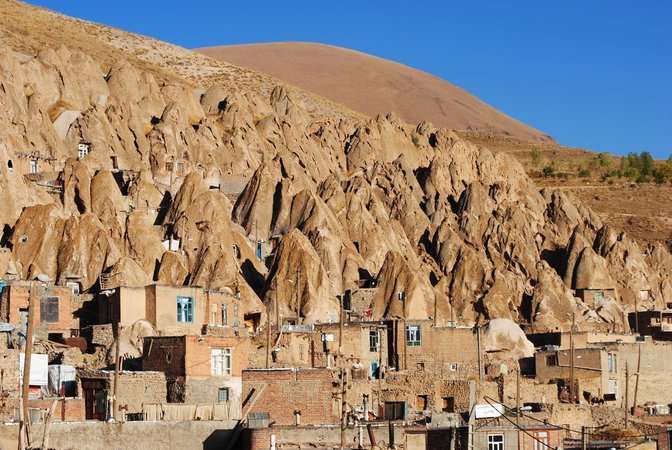
Kandovan. Iran.
History of the XX century
The twentieth century is precisely that period in Iranian history which interests me the most, because it gives answers to such questions such as: what role did America, England and Russia played in Iranian history, why Shah came to power or rather who helped him to achieve it and why, why Iranians willingly chose a Muslim government which then turned into another regime, and who extended a “helpful” hand in the war between Iraq and Iran and why did it brake out.
My story begins in the nineteenth century when Iran was ruled by the Qajar dynasty of Turkmen origin which incompetent and weak rulers lost the territories in their sphere of influence to Russia and to Great Britain. It was a time when one of the Shahs sold national wealth one after another just to satisfy his private desires such as art collections and building lavish palaces. Persian banks, railways and many other goods were sold for pennies to the UK and other important parts of the economy such as for example the tobacco industry followed. In the beginning of the twentieth century the economic situation was so bad that in different parts of the country uprisings started breaking out and Shah was not able to respond. At the time Russia urged the Shah to break his word given to the British what only resulted in even more uprisings, Shah’s brutal dictatorship and split of the parliament and finally abdication of the Shah. As a result during World War I Russia controlled northern Iran and the United Kingdom southern Iran, and additionally Turks murdered Christians in the north-west. Benefiting on chaos Iran’s Gilan province broke away and even Ahmad Shah was unable to respond, that’s why Britain installed a stronger officer called Reza Khan who managed to take back Gilan. This means that in 1921 Reza Khan organized a coup and got rid of the last Shah of the Qajar dynasty. Reza Khan who was the first of the Pahlavi dynasty is today regarded as a puppet of the United Kingdom who was nevertheless a brave soldier and had ambitious plans to modernize Iran. Reza Khan took Ataturk for his role model and just as him he demanded western-style clothing, introduction of Western culture and destruction of Muslim clerics.
However not everyone agreed with the Shah’s “modern” politics and a lot of women despite clear prohibitions of wearing a hijab still dressed in a traditional Muslim way, to show their support for the Muslim clerics. In the times of World War II Reza Khan spoke openly about his support for the Nazis what the British and the Russians could not bear, and that’s why in 1941 he had to leave Iran. Then the United Kingdom put his son in his place; a young 22 -year-old Mohamad Reza who had absolute power over Iran but after all he was still under strong influence of the British. In the 1940’s and 1950’s an important situation took place which in my opinion has a close relationship with the current “axis of evil”. Translating it from the language of the naive into the language not paralyzed by Zionism “the axis of evil” means “we want your oil and we want it for free”. This meant that the new wealth which was oil was in the hands of the British and the Shah was still covering giving out Iran’s riches behind emancipation of women, what was happening simply too fast. In 1951 a nationalist came to power who promised to take the British away from the trough and put an end of controlling Iran by the colonial power, but two years later he was removed by the British and the Americans. Then oil was de-nationalized again and because of the Churchill’s boycott and his partnership with Eisenhower America earned a fortune on oil which was not even theirs. At the same time America still continued to urge its Shah to introduce reforms leading to de-Islamization of Iran, what was nicely called the White Revolution.
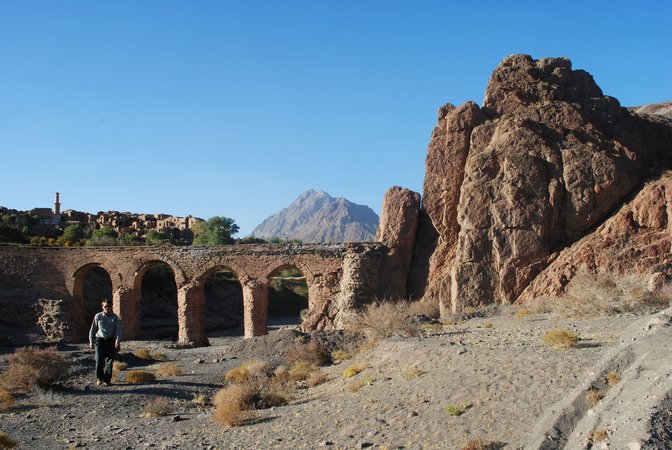
A Muslim cleric Ayatollah Khomeini who was the leader of opposition did not agree with the politics of a traitor and did not agree with Iran being controlled by a foreign power. In 1964 the Shah even issued a law saying that U.S. soldiers in Iran could not be arrested under any circumstances, and Khomeini replied that “when Americans drive over a dog in America they would face trial for that, but if Americans drive over Iranians they are instantly innocent”. Khomeini was deported and the Shah at the service of Americans organized an expensive party in Persepolis to honour the 2,500th anniversary of the Persian Empire, what in the eyes of the people made him look like a money waster. In 1974 the price per barrel of oil jumped dramatically but thanks to Americans that money was wasted. Then the price of oil fell dramatically and the world fell into recession, reforms had to be cancelled and Iranians were very unhappy. In such conditions the Pahlavi dynasty earned more enemies. Clerics wanted to reverse the reforms, students wanted the reforms to be introduced faster, although everyone regardless of opinions in some way attacked the Shah. As a result of that from time to time uprisings were braking out and the Shah was forced to deal with his people in a brutal way what only heated up the situation. I was personally in the Ebrat museum in Tehran which was once a prison for Shah’s political enemies. Shah’s servants used various tortures techniques including burning people, starvation and hammering nails into their fingers. On the 16 January 1979 the Shah and his family left Iran and Ayatollah Khomeini returned from France and became the Supreme Leader. The opposition was soon murdered and Khomeini created a country in which power was in the hands of Muslim clerics, no matter who would become the president or the prime minister. In March 1979 a referendum was held in which Iranian people voted for the creation of the Islamic Republic of Iran by giving it a 98% support. Then in November 1979 there was an attack on the U.S. embassy after the ultra-conservative students held 52 employees hostage for 444 days. It was an action to which Khomeini gave his Muslim support and to make the things look more democratic the Supreme Leader put into the positions of the president and the prime minister his conservative friends. An important politician at that time was a man called Ayatollah Teleqani whose ideas were less ultra-conservative and I think that if he had come to power during that time Iran could benefit from this today. Unfortunately Khomeini came to power and first overthrew the Shah and then introduced a new regime which continues until today.
The next stage in the Iranian history was the war with Iraq. Iraqi President Saddam Hussein was building a strong army which at that time was much stronger than the army of Iran. Saddam Hussein had also his vision about the region and he dreamt about domination over all neighbouring countries. He saw for example an oil rich Iranian province of Khuzestan as historically Iraqi, and later he also saw oil-rich Kuwait as part of Iraq. Iran however had Muslim fanaticism on its side which was further fueled by the Muslim clerics, perhaps also greater spirit and it had greater population because Khomeini banned contraception. The war with Iraq was bloody and merciless. During the eight years half a million people on each side were killed, and in addition both countries were devastated. About 90 towns and 3000 villages were bombed by Iraq, and when I travelled around Iran I saw lots pictures of the killed soldiers and I’ve been to many war museums. The war was also a very good time for Khomeini because he could once and for all get rid of political opponents what usually took place in mysterious bombings. It is also worth mentioning that bomb blowing specialty has become the permanent ritual in the Muslim culture. American also played an important role in the war because they supplied Iraq with both conventional and chemical weapons; and many years after they accused Saddam Hussein of possessing weapons of mass destruction, which he already did not have because he killed Iranians with it. It has been calculated that only by using chemical weapons which Iraq got from America Saddam killed about 20,000 Iranians. The best part of this story is that the war earned a lot of money to many European countries and China, Russia, and probably everyone except the Pope. America also sold weapons to Iran and almost every country sold weapons to both sides. The funny thing is that Israel also bombed a nuclear reactor in Iraq and sold weapons to Iran in a hope that if they fight longer they will bleed faster.

Bridge in Esfahan. Iran.
After Khomeini’s death in 1989 the top job was taken over by Ayatollah Ali Khameni. Social and religious sentiments were the same but it was also a time of rebuilding the country after devastating war and a time of reforms. Among many other things contraceptives were introduced because the population grew to frightening numbers, as well as the construction of roads, water and electrical connections. An important name was Ayatollah President Khatami, who was a great reformist and pulled up the economy and quality of life in Iran, and what is also very important he reformed the social life. Women no longer had to dress ultra-conservatively, they began to dye their hair and cuddle their boyfriends in the streets. After the first term in 2001 Khatami was re-elected with 78 % support but could not do anything because it was opposed by the ultra-conservatives to such an extent that the president had no longer any power. In 2005 Mahmoud Ahmadinejad won the elections; sharp-tongued populist who promised that the money from oil would be on the tables of average Iranians, and he started a nuclear program which should not be confused with construction of a nuclear bomb. Of course the U.S. for propaganda purposes understood that only in one way by which Iran has become more and more unpopular and economic sanctions followed which severely hurt the standard of living in Iran. Ahmadinejad expressed himself about Israel and America in a very honest way, and his comments became a breeding ground for the Western media, which purposely translated his speeches the way they wanted. In 2009 Ahmadinejad won by probably only one vote which led to riots in major cities and the West once again had reason to say that it was a problem of Muslim fanaticism. In this case it was untrue but stripped of real education societies of the U.S. or England fell for it very easily. Currently the president in power is called Rouhani, who is milder than Ahmadinejad and who is trying to set a deal with the U.S. over his nuclear program simply to improve the Iranian economy. Israeli Prime Minister calls him a wolf in sheep’s clothing what means that tense situation continues.
Ayatollah Ruhollah Chomeini
I would like to include this short chapter to express my personal opinion about Khomeini. I agree with the fact that Khomeini overthrew the Shah who kept on selling out national riches and was a puppet in the hands of Americans. On the other hand what Khomeini did was not better at all. His changes were very different to Shah’s policies although what Khomeini did and what is valid until today is based on theocracy and in his case on religious fanaticism. During the Iran -Iraq war Saddam Hussein placed land mines and in response Khomeini sent children to the minefields saying that if they die as martyrs and “clear” the mines and die they would go straight to heaven. Khomeini also made it legal for 9 year old girls to get married. Those dirty dealings are in force in Iran today but from the age of 13, although it happens to younger children too. Of course it stinks to me with paedophilia what is inseparably linked with Islam. Khomeini also limited women’s rights (as a result of his policy) to the right to live and the right to give birth; he limited social rights and consequently turned back Iran in time. When Khomeini overthrew the Shah he seemed to be a fresh breeze for a better tomorrow in Iran but he turned out to be a polluted air for his people, which suffer from his politics until today and the traditional Persian culture with it.
Currently many schools, roundabouts and streets are named by his name and Khomeini has arisen to the status of Imam what means a saint in Shia Islam. Whilst travelling around Iran I saw his placards showing his gloomy look coming out from under his bushy eyebrows. For the West at that time Khomeini became the symbol of Islam in a bad sense which has been used by pop-culture as a symbol of Islamic fanaticism. Why Imam Khomeini became Imam I simply do not know and I suspect that a lot of Iranians also ask themselves the same question. During my Iranian trip I saw a lot of posters showing victims of the Iran-Iraq war but I never saw posters showing children with the inscription “blown up by a mine at the order of Khomeini “. I also never saw posters showing 9 year-old girls with words “died in childbirth in accordance to the Khomeini’s law.” Nonsense associated with the cult of Khomeini continues and it is such an absurd that in the outskirts of Tehran there is even a huge mosque in the form of a palace which serves as his burial ground. I wish all Iranians great awakening.
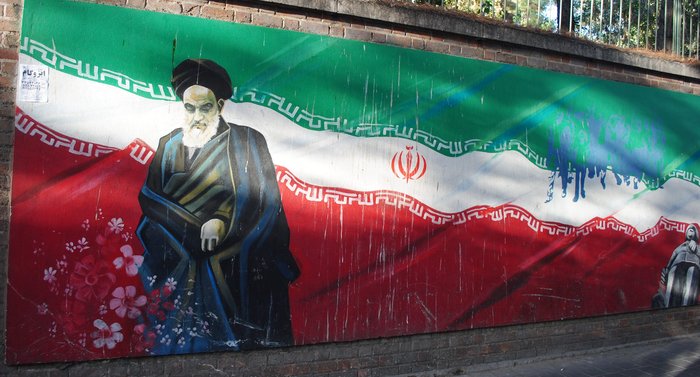
Ayatollah Khomeini with the Iranian flag in the background.
Travel reports
Map
Location
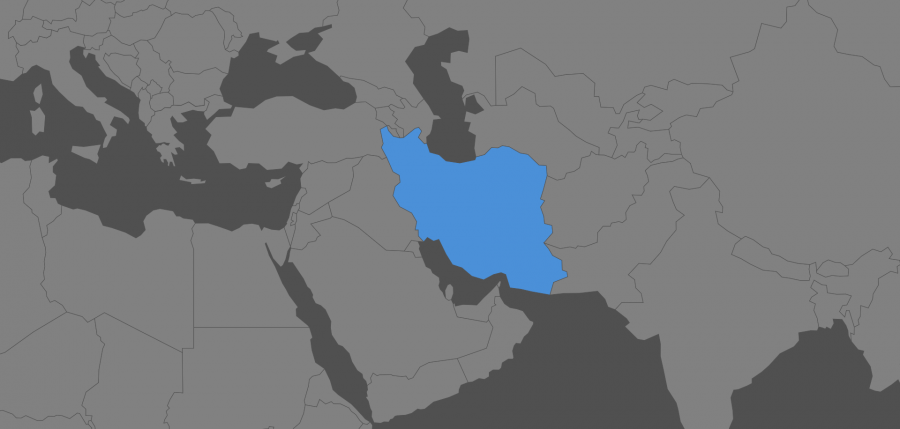
Practical information
Tourist visa: Fortunately, in 2019 Poles can obtain an Iranian visa on arrival at airports, which entitles them to a 30-day stay. For example, the British have to undergo the visa procedure, which I still experienced on my Polish passport in 2013. It’s good to be Polish in Iran.
For citizens of countries who are not entitled to a visa on arrival, trip around Iran starts before entering the country, because we have they waste time for bureaucracy in order to get the visa. In 2013 first I organized a paid invitation via an agency and even though each one of them has slightly different approach, they all want a tourist to fill a form about the reason for travelling and a travel plan. After few weeks later, in case of acceptance by the foreign ministry the agency sends a code which we have to take to the previously chosen embassy.
I paid $30 for my invitation and those agencies which I can recommend are www.uppersia.com, www.key2persia.com oraz www.iranianvisa.com.
When I had a code from the agency I filed my visa application in the Warsaw embassy (although to those who travel around countries neighbouring Iran I advice to chose an embassy in a more convenient country), and after filling out the form, attaching 2 photos and 50 Euros I received my visa after few days. To certain embassies women should bring photos with a covered had according to the Muslim dress code.
For some reason the easiest place to buy Iranian visa is the consulate in Trabzon in Turkey. That consulate does not require paid invitation and a 30 day tourist visa can be sometimes obtained within 2 or 3 hours.
Tourist visa extension is very easy whilst in Iran and can be made at any police station for a small fee.
Israeli citizens can not enter Iran, and Israeli stamp in any passports and any evidence of travelling to Israel also makes entering Iran impossible. Americans can enter Iran but only on organized tours.
Safety: Contrary to the hate propaganda advertised by the Zionists, Iran is a very safe country for tourists. I spent 1.5 month in Iran and every time Persians proved to be as friendly and as helpful as their English made it possible. Persian nation is friendly towards tourists.
Moving around the country: Iranian transport is very well organized. The are buses and train networks reaching every corner of Iran. I only used night buses because those were cheaper than trains and I could also chose a class of the bus. The roads are smooth that’s why moving around Iran is not painful as it is for example in India. Apart from that I also hitchhiked a lot which turned out to be rich in adventures. Taxis are of course more expensive but if they are shared by 4 people it works out well. For a shared taxi from Qom to Kashan I paid only 60.000 Rial.
Prices (in 2013 when £1=50 000 Rial at a street price): The cost subject in Iran is a complex matter. Generally travelling around is cheap and classify this country as a low budget destination. For a room or a bed in a dormitory I usually paid 150.000 Rial although sometimes I also paid 100.000 and every rarely 250.000 Rial. For meals in traditional but cheap Persian restaurants I used to pay maximum 100.000 Rial and for all food I used to spend on average 300.000 Rial a day. Also hamburgers and sandwiches are very popular in Iran which comparing to the traditional Persian cuisine are very bad but very cheap. Meal of that type I usually costs 25.000 Rial. Transport is also very cheap. For a night bus from Mashhad to Tehran (14h drive) I paid 185.000 Rial, and for a night bus from Yazd to Shiraz (7h drive) only 115.000 Rial. I think that a budget of $20 a day is enough although I used to spent less because I slept in my tent and I hitchhiked very often. Everyone can effort Iran.
There are also two more things that need explanation. Iran (the same as Uzbekistan) has two rates: a bank rate which is the low one, and the street rate which is the real one. This means that banks should be the last places to exchange money. Another important thing is naming the money. Rial is the official currency of Iran although everybody uses name “tuman” what means that Iranian nation has unofficially done denomination of their own currency by themselves. Tuman means Rial minus one zero. This means that if we pay 50.000 Rial for a meal we pay 5000 tuman. It is important to ask a waiter, a taxi driver or a hotel manager if they mean Rial or Tuman as a way of payment. From my own experience it would most often Tuman because it is easier with a smaller number of zeros.
Climate: Iran has a very diverse climate. Generally a dry climate dominates in Iran which during summers reaches around 35°C do 40°C and in the south by the Persian Gulf even 50°C. Precipitation is also very small because most of Iran is covered by a dry desert. During winters in the same territories the air temperature reaches about 25°C -28°C. The only exception is the Caspian Sea area where the climate is mild and delicate with most precipitation. The are also mountains like for example the whole chain of Alborz Mountains where temperatures drop below zero, and at the top of Damavand temperatures drop down to -40°C even during summers. As I said these are however only exceptions because Iran is a dry and hot country.



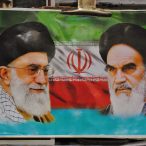
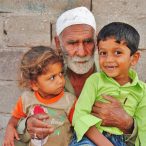
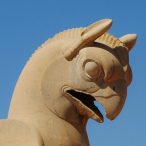
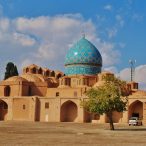






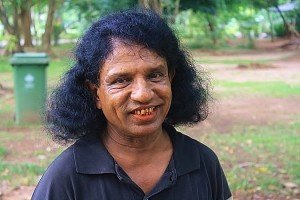
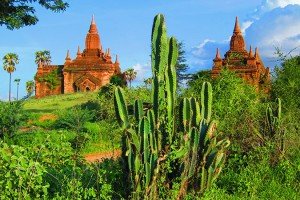
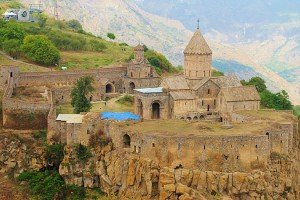
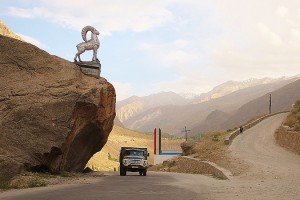

Hamid
Impressive, thanks for traveling to Iran.